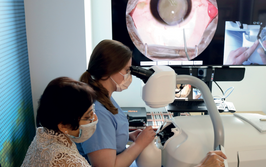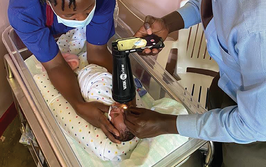AI Hopes
We speak with Elad Serfaty, Chief Executive Officer of OrCam Technologies, about assistive technology for patients with low vision
Julian Upton | | 4 min read | Interview

Credit: Headshot supplied by Elad Serfaty
How can people with mild to severe vision loss benefit from AI assistive technology?
Innovative assistive technologies that leverage artificial intelligence (AI) can play a vital role in enhancing the lives of individuals with low vision. They help people remain independent and maintain a better quality of life. Some assistive technologies are tailored to specific disease states, such as specialty spectacles designed for people with degenerative retinal diseases; others are designed to work irrespective of an individual’s specific pathology. Technologies in the latter group offer wider utility and flexibility, and can be adapted to work for a patient’s unique needs. Because these disease-agnostic assistive technologies do not belong exclusively to the realm of a single specialty, eye care providers at any level of care can recommend them to patients with low vision.
What assistive technology trends are emerging – and what is OrCam working on?
Among the earliest digital assistive technologies were digital magnifiers, which allowed patients with low vision to more clearly see text. This was useful for patients whose remaining vision allowed them to recognize printed characters. They more or less served as electronic handheld magnifiers – useful devices, but hardly ones that represented the cutting-edge of innovation.
The next iteration of assistive technology that specialized in reading text relied on optic character recognition (OCR) software. This not only recognizes characters and words so they can be read aloud, but can also discern if two groups of words near each other on the page or screen are related. It allowed patients to digest a newspaper or magazine, where columns of unrelated text appear in similar sizes and fonts. As assistive technologies become more advanced, OCR software is becoming more sophisticated. The OrCam Read 3, for example, while functioning as a smart magnifier and a stationary reader, allows users to point the device at a book, a screen, or wherever there is text, and read the text aloud or through earphones. It features an intuitive AI assistant that instantly summarizes text, whether a few sentences or an entire page.
OCR isn’t the only impressive software innovation in this space. One of OrCam’s newest features is its wearable AI device, MyEye, which provides users with data about what’s around them, answers their questions, and uses facial recognition software to help with person-to-person interactions. These advancements represent the vanguard of assistive technology for people with low vision, allowing users to find much greater independence.
Using AI, these technologies can interpret data rather than simply regurgitate preloaded information. Users can ask similar but distinct questions such as “Who am I facing?” and “Who is in front of me?” The facial recognition software can “learn” unique faces in various contexts (for example, if they’re wearing glasses, make-up, or a hat) – and this dataset becomes more robust over time.
What does the future hold for this technology?
AI systems that ingest more data grow more sophisticated, and we can expect their accuracy to improve as their databases expand. User prompts requesting information on object descriptions should become more specific in the near future, and requests to read text should further improve in accuracy.
Increases in specificity to prompts such as “What is in front of me?” must be balanced with practical utility, however – just because a device can offer a 100-word description of a room doesn’t mean that it should. A wordy response may be more of a nuisance than it is helpful. Striking that balance will be key to ensuring that ever-evolving assistive technologies accomplish their goal of being user friendly and enhancing patients’ lives with negligible interference.
Julian Upton is Group Editor of The Ophthalmologist and The New Optometrist. With 20+ years' experience of the magazine industry, he has covered many facets of science and healthcare.













